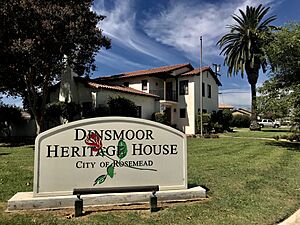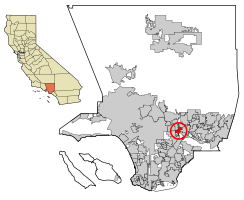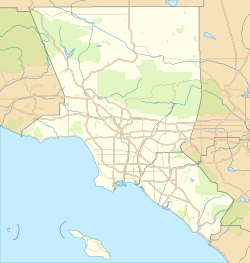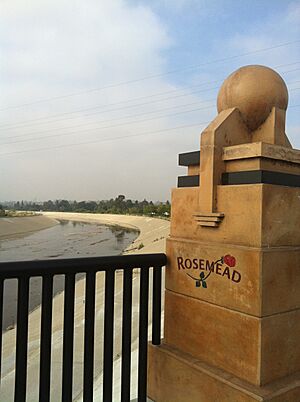Rosemead, California facts for kids
Quick facts for kids
Rosemead, California
|
|||
|---|---|---|---|
 |
|||
|
|||

Location of Rosemead in Los Angeles County, California
|
|||
| Country | |||
| State | |||
| County | Los Angeles | ||
| Incorporated | August 4, 1959 | ||
| Government | |||
| • Type | Council-Manager | ||
| Area | |||
| • Total | 5.18 sq mi (13.40 km2) | ||
| • Land | 5.16 sq mi (13.37 km2) | ||
| • Water | 0.01 sq mi (0.04 km2) 0.26% | ||
| Elevation | 318 ft (97 m) | ||
| Population
(2020)
|
|||
| • Total | 51,185 | ||
| • Density | 10,472.30/sq mi (4,043.41/km2) | ||
| Time zone | UTC−8 (PST) | ||
| • Summer (DST) | UTC−7 (PDT) | ||
| ZIP Codes |
91770–91772
|
||
| Area code(s) | 323/626 | ||
| FIPS code | 06-62896 | ||
| GNIS feature IDs | 1656611, 2410998 | ||
Rosemead is a city in Los Angeles County, California, United States. In 2020, about 51,185 people lived there. Rosemead is part of a group of cities in the western San Gabriel Valley. This area has a growing population of people from Asian backgrounds. It also has many people from Mexico and other Latino countries.
Contents
History of Rosemead
Early Inhabitants and Spanish Missions
Before the Spanish arrived, the area where Rosemead is now was home to Native Americans. These people were called the Kizh (or Tongva), and the Spanish later named them the Gabrieleños.
In 1771, the Spanish built the first Mission San Gabriel Arcángel nearby. This mission was later moved in 1775 to its current spot in San Gabriel.
Mexican and American Eras
During the time of Spanish rule, the Rosemead area was managed by the San Gabriel Mission. Later, when Mexico governed the land, it was given to private citizens. This ended the Mission Era.
After the Mexican–American War in 1848, California became part of the United States. People from other parts of the US, often called Anglo-Americans, began to move to the area. The southern part of Rosemead was once a large ranch called Rancho Potrero Grande.
How Rosemead Got Its Name
In 1852, John and Harriet Guess traveled to the San Gabriel Valley from Arkansas. They bought land in 1867 and named it Savannah.
Other early settlers included Frank Forst and Leonard John Rose. Rose bought about 600 acres of land. He raised and trained horses on his ranch, which he called "Rose's Meadow." This name was later shortened to Rosemeade, and then finally to Rosemead.
The community grew with small farms, raising vegetables, fruits, and animals. On August 4, 1959, the people of Rosemead voted to make it an official city.
Rosemead Airport's Past
Rosemead once had an airport called Rosemead Airport. It was built between 1940 and 1942. Western Air College ran the airport and also had a flying school there.
Later, a company called Fletcher Aviation bought the airport. In the 1960s, the land was sold again. A large facility called Flair Park was built there, and a road was named Flair Drive.
Population and People
Rosemead is known for its diverse population. Many people in Rosemead are from Asian backgrounds, especially Chinese and Vietnamese. There is also a large population from Mexico and other Latino countries. Less than 1% of the people are African-American or Native American.
Population Changes Over Time
| Historical population | |||
|---|---|---|---|
| Census | Pop. | %± | |
| 1960 | 15,476 | — | |
| 1970 | 40,972 | 164.7% | |
| 1980 | 42,604 | 4.0% | |
| 1990 | 51,638 | 21.2% | |
| 2000 | 53,505 | 3.6% | |
| 2010 | 53,764 | 0.5% | |
| 2020 | 51,185 | −4.8% | |
| U.S. Decennial Census | |||
Rosemead's Population in 2010
The 2010 United States Census counted 53,764 people in Rosemead.
- About 60.7% of the people were Asian.
- About 33.8% were Hispanic or Latino.
- About 21.1% were White.
- Other groups made up smaller parts of the population.
Most people lived in homes, with only a small number in group living situations. The average household had about 3.74 people. Many households had children under 18. The average age in Rosemead was 38.1 years old.
About 49% of the people lived in homes they owned, and 50.3% lived in rented homes. The average income for a household in 2010 was $45,760.
Rosemead's Population in 2000
In 2000, Rosemead had 53,505 people.
- About 48.76% were Asian.
- About 41.30% were Hispanic or Latino.
- About 26.57% were White.
The average household had 3.70 people, and the average family had 4.19 people. The median age was 39 years. The median income for a household was $44,115.
The most common backgrounds were Mexican and Chinese. Many people were born in Vietnam and Mexico.
City Services
Emergency Services
The Los Angeles County Fire Department provides fire protection for Rosemead. American Medical Response provides ambulance services. The Los Angeles County Sheriff's Department handles law enforcement from its Temple City Station.
Local Infrastructure
The Los Angeles County Sheriff's Department (LASD) has a station in Temple City that serves Rosemead. The Los Angeles County Department of Health Services operates a health center in Monrovia for Rosemead residents.
Economy and Businesses
Rosemead is home to several important companies and organizations.
- Edison International, a company that provides electric services, has its main office here.
- Southern California Edison serves electricity to Rosemead and much of Southern California.
- The University of the West, one of the first Buddhist-funded universities in the US, moved to Rosemead in 1996.
- The Rosemead School of Psychology, now part of Biola University, was named after its original location in Rosemead.
- The Chinese fast-food chain Panda Restaurant Group is also based in Rosemead.
- Huy Fong Foods, Inc., known for its Sriracha red chili sauce, was based in Rosemead. Their sauce is now made in nearby Irwindale.
Major Employers in Rosemead
Here are some of the biggest employers in Rosemead:
| # | Employer | # of Employees |
|---|---|---|
| 1 | Edison International (Southern California Edison) | 2,722 |
| 2 | Garvey School District | 881 |
| 3 | Panda Restaurant Group | 647 |
| 4 | Wal-Mart | 597 |
| 5 | Rosemead School District | 329 |
| 6 | Target | 200 |
| 7 | Hermetic Seal | 120 |
| 8 | Lucille's | 100 |
| 8 | Doubletree | 100 |
| 8 | University of the West | 100 |
Geography of Rosemead
Rosemead is located at coordinates 34°4′N 118°5′W / 34.067°N 118.083°W. The city covers about 5.2 square miles (13.4 square kilometers). Most of this area is land, with a very small amount of water.
Neighboring Cities and Areas
Rosemead shares borders with several other cities:
- To the north: San Gabriel and Temple City.
- To the east: El Monte and South El Monte.
- To the south: South San Gabriel (an unincorporated area) and Montebello.
- To the west: San Gabriel and Monterey Park.
Education in Rosemead
Rosemead has two elementary school districts: Garvey School District and Rosemead School District. Students then go on to high school in different districts.
High Schools and Middle Schools
There is one public high school in the city, Rosemead High School. It is part of the El Monte Union High School District. There are also three public middle schools:
- Muscatel Middle School
- Richard Garvey Intermediate School
- Roger W. Temple Intermediate School
Some parts of Rosemead are zoned for San Gabriel High School (part of Alhambra Unified School District) or the Montebello Unified School District.
Private Schools and Universities
Don Bosco Technical Institute is a private Catholic high school for boys in Rosemead. University of the West has been in Rosemead since 1996. It is the only university in Rosemead that is accredited by the Western Association of Schools and Colleges.
Places to Visit in Rosemead
Dinsmoor Heritage House
The Dinsmoor Heritage House is a small museum that shows the history of Rosemead. It was once a private home built in the 1920s by Adelberrt Dinsmoor, whose father was an early pioneer in Rosemead. The museum is currently being updated. When it reopens, it will offer tours and special events.
Marinelli Stadium
Marinelli Stadium is located at Rosemead High School. It is named after Rod Marinelli, a former head coach for the Detroit Lions football team. His name is lit up above the scoreboard.
Community Centers and Aquatic Centers
Rosemead has two community centers. They offer spaces for events, senior activities, adult education, and classes for kids and adults. They also have two preschools.
The city has also updated its two aquatic centers:
- Rosemead Aquatic Center in Rosemead Park has facilities for swimming, water polo, and diving. It also offers swim classes.
- Garvey Aquatic Center is a modern recreational pool with water slides, play areas, and a lesson pool.
City Parks
Rosemead has several parks where you can enjoy the outdoors:
- Garvey Park, at 7933 Emerson Place.
- Rosemead Park and 1/2-Mile Fitness Trail, at 4343 Encinita Avenue.
- Klingerman Park, at 8800 Klingerman Avenue.
- Sally Tanner Park, at 8343 E Mission Drive.
- Zapopan Park, at 3018 N. Charlotte Avenue.
- Jay Imperial Park, at 2373 Pine Street.
Savannah Pioneer Cemetery
Savannah Memorial Park is a historic cemetery in Rosemead. It is thought to be the oldest Protestant cemetery in Los Angeles County. The first known burial there was in 1846. The cemetery is privately owned and maintained by the El Monte Cemetery Association.
When Valley Boulevard was widened in the 1920s, construction workers found many old graves outside the cemetery fence. Most of these remains were reburied inside the cemetery. This area was also a Native American burial ground before settlers were buried there.
Shopping and Commerce
A small part of the Montebello Town Center shopping mall is actually within Rosemead city limits. This mall has large department stores, smaller shops, and a food court.
Rosemead also has an Asian shopping center on Garvey Avenue, which used to be called The Diamond Square Shopping Center. It has many restaurants and Chinese shops. Nearby is The Square Supermarket, which sells Korean and Vietnamese foods. Rosemead Square Shopping Center is located on Rosemead Boulevard.
Media and News
News about the Rosemead community is covered by the San Gabriel Valley Tribune, a daily newspaper. There are also community weekly papers like Mid-Valley News and Rosemead Reader.
Famous People from Rosemead
Many notable people have connections to Rosemead:
- Isaias Hellman, a banker and supporter of the University of Southern California.
- Taboo from the music group The Black Eyed Peas.
- Toscha Seidel, a famous violinist.
- Vikki Carr, a singer.
- Bob Mackie, a fashion designer.
- Rod Marinelli, a former head coach for the Detroit Lions football team, was born in Rosemead.
- Prima J, a musical group.
- Jose Flores, a Major League Baseball player.
- Audie Desbrow, the drummer for the rock band Great White, was born and raised in Rosemead.
- Venus D-Lite, a drag queen.
Sister Cities
Rosemead has two sister cities, which are cities that form a special bond to promote cultural ties:
Images for kids
See also
 In Spanish: Rosemead para niños
In Spanish: Rosemead para niños








